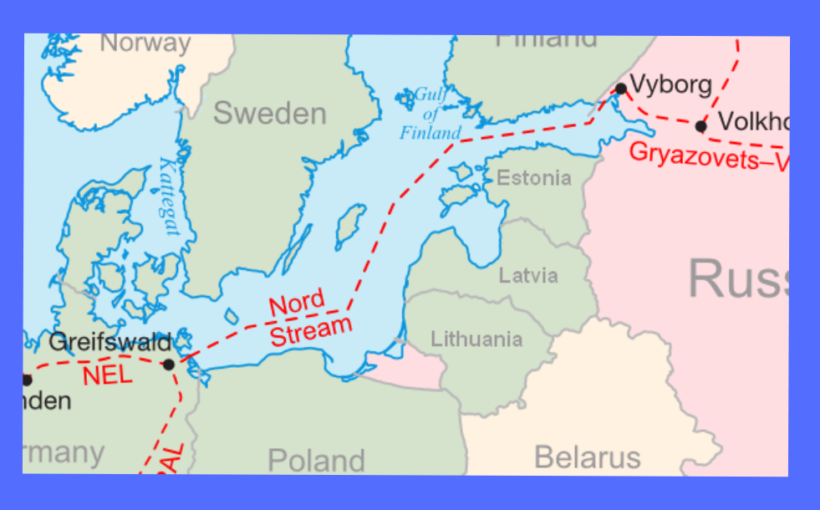Russia shuts down Nord Stream Pipeline, also called the Gas Pipeline. An energy crisis is now looming upon Europe, that could lead to factories shutting down, triggering of frequent blackouts, and could also thereby invoke another recession.
The Pipeline
Gazprom Group had built a natural gas pipeline called Nord Stream Pipeline between Russia and Germany under the Baltic Sea. There were two lines built, Nord Stream 1 and Nord Stream 2, in order to boost the flow of Russian natural gas into Europe.
The Pipeline – Nord Stream 1
Since its completion in 2011, Nord Stream 1 has been delivering natural gas to European nations, including Germany, without any glitches. The second pipeline, Nord Stream 2, has, however, encountered considerable criticism and obstacles, mainly from the United States and other European nations.
The Pipeline – Nord Stream 2
Europe’s increased dependence on Nord Stream 2 and it’s repercussions on the political scenario is the primary concern. By avoiding the conventional transportation links through Eastern Europe and Ukraine, critics contend that the pipeline will increase Russia’s energy sway over Europe and compromise the security of the continent’s oil supply. The project has also drawn concern for its potential effects on the ecosystem of the Baltic Sea.
The resistance to Nord Stream 2 has initiated a number of different forms, such as diplomatic initiatives, economic sanctions, and legislative obstacles. Particularly the United States has been an outspoken critic of the pipeline, claiming worries about Russia’s hold over the energy supplies of Europe and its effects on Ukraine. The National Defence Authorization Act (NDAA), which contained sanctions against firms participating in the development of Nord Stream 2, was passed by the United States in December 2019. The completion of the pipeline has been delayed and complicated by these penalties.
There have been numerous additional construction issues and delays with the pipeline project. Technical difficulties, governmental restrictions, and financial pressures have all been part of these difficulties. For instance, because to U.S. sanctions, Nord Stream 2 development was momentarily put on hold in December 2019. The project’s completion has also been hampered by legal disputes and opposition from some European nations.
The Nord Stream Pipeline Disasters
Three of the four Nord Stream pipelines were ruptured in September 2022 as a result of a sequence of undersea explosions in the Baltic Sea. Massive explosions beneath the sea in the very same region were found to be the leak’s cause by seismologists. The pipelines were not operating but we’re filled with methane gas. The explosions were massive enough to bring bubbles, a kilometre long, to the surface.
Geopolitical factors and worries over the security of the European energy supply are the main reasons against Nord Stream 2. The pipeline’s development has run into challenges and setbacks, as with any significant infrastructure project.
Events that led to the Closure of the Nord Stream Pipeline
Gazprom, Russia’s state-owned exporter said Nord Stream 1 pipeline carrying gas to Germany would stay closed. Gazprom blamed it on an oil leak. It further attributed the cause of the closure to various sanctions that prevented several dealings with Russia and therefore the problems Gazprom said could not be fixed.

After the war began, Russian businesses, banks, and the public were subject to sanctions by European countries. Russia hit back by cutting off supplies of cheap natural gas that the European continent depended on for years to run its factories, generate electricity as well as heat homes apart from other applications.
Impact On Europe By the Nord Stream Pipeline
European governments are now desperate for alternative supplies to soften the impact as economic growth slows and energy gets expensive.
Just before the war in Ukraine had started, Russia had cut back all its gas supplies. This had resulted in Gas prices to soar, last summer.
Impact on Russia By the Nord Stream Pipeline
But this has come at a price for Russia too. Their gas shipments have fallen 89 per cent from a year ago. Russia used to supply 40 per cent of Europe’s natural gas.
Europe was dependent on Russian energy. For this reason oil and gas imports were initially exempt from sanctions. This maintained Russia’s income from sales, due to the skyrocketing prices, even as gas sales dwindled.
SOS Measures Adopted by Europe to fight Energy Crisis
Europe has learned a lesson and lined up all the alternative gas supplies it could: Diverting funds for buying liquefied natural gas, or LNG from the United States and pipeline gas from Norway and Azerbaijan.
Cutting down on their policies to reduce greenhouse gases, Germany is keeping coal plants in operation. They will also keep open the option of reactivating two nuclear plants it’s set to shut down. Other measures include tax breaks, bailouts for utilities, cash cards, etc.
Russia has struck at the very root level of humanity as Europe faces a very cold winter. But humanity has faced bigger challenges in the past and has emerged triumphant too.
Informative Useful Links




